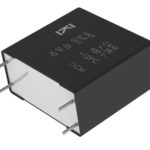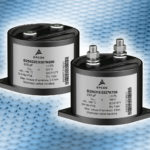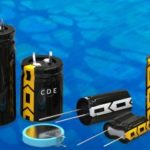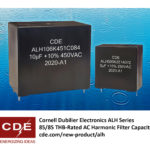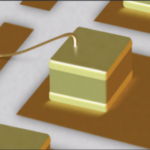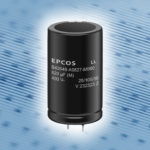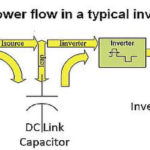KEMET, part of the YAGEO Group and leading global electronic components supplier, announces its new C4AK high temperature, power film DC-Link capacitor designed for continuous operation up to 1,000 hours at 135℃. The C4AK series joins the C4AU (harsh environment) and C4AQ-P (125°C) family of power DC-Link film capacitors. These series offer higher capacitance density, […]
Capacitors
Power capacitors excel at dc link applications
TDK Corporation presents a new series of EPCOS power capacitors for DC link applications. The new capacitors are available for rated voltages of 700 V DC to 2000 V DC and cover a capacitance range of 20 µF to 270 µF. The current handling capacity can be up to 60 A at 65 °C with […]
Dielectric film improves efficiency of high-temperature, high-voltage capacitor applications
SABIC introduced its new 5-micron ELCRES HTV150 dielectric film for high-temperature, high-voltage, professional-grade capacitor applications, such as traction inverters for hybrid, plug-in hybrid, and battery electric vehicles (xEV). This new film, featuring high-heat performance up to 150°C, surpasses the temperature and voltage capabilities of incumbent products. ELCRES HTV150 film can help support the transition from […]
Super-caps cover 0.5 to 600-F range at up to 3.0 V
The DGH 2.7-V and DSF 3.0-V series supercapacitors (aka EDLCs or ultracapacitors) are used to supplement rechargeable batteries or as replacements for batteries in a diverse range of applications. These new components add powerful options for engineers. According to Brendan Andrews, Cornell Dubilier Business Unit Manager, “Our technology is used in a wide variety of […]
85/85 THB-rated AC filter capacitors designed for harsh environments
Designed for harsh environments, Cornell Dubilier’s new ALH series of AC-rated filter capacitors offer 50% greater life than competitive 85/85 THB-rated film capacitors. The Temperature, Humidity at Bias (THB) test exposes parts to the harsh conditions of 85 °C at 85% relative humidity with rated voltage applied. CDE’s testing has been validated for 1,500 hours, […]
AC filter capacitors optimized for harsh environments
The new ALH series of ac-rated filter capacitors offer 50% greater life than competitive 85/85 THB-rated film capacitors. The Temperature, Humidity at Bias (THB) test exposes parts to the harsh conditions of 85°C at 85% relative humidity with rated voltage applied. CDE’s testing has been validated for 1,500 hours, while competitors validate their series for […]
High-frequency 100-nF capacitors improve bypass performance in GaN/GaAs amplifiers
Knowles Precision Devices recently announced the release of a new 100nF capacitor within its V-Series of single-layer capacitors. The 100nF is a high frequency, wire bondable single layer capacitor, making it ideally suited for GaN and GaAs amplifier applications where small size and microwave performance are critical. V-Series single-layer capacitors, including the new 100nF, are […]
Calculation tool covers electrolytic capacitors up to >150 V DC
TDK Corporation presents the fully revised version 4.0 of the tried and tested Online AlCap Useful Life Calculation Tool for EPCOS aluminum electrolytic capacitors. The tool covers all new high-voltage capacitors (>150 V DC) with screw, snap-in and solder pin connections. These DC link capacitors are particularly suitable for new designs of converters for industrial […]
Snap-in aluminum electrolytic capacitors sport outstanding ripple-current specs
TDK Corporation presents the new EPCOS aluminum electrolytic capacitor series B43548* with snap-in terminals. The capacitors feature an excellent maximum ripple current capability of 9.80 A (400 V, 100 Hz, 60 °C). This makes them ideal for demanding applications in power electronics. The capacitors are designed for a maximum operating temperature of 105 °C, have […]
Selecting dc-link capacitors for inverters
One key factor: Determining the nuances of how capacitors handle expected ripple currents. Sam G. Parler, Jr., P.E. Cornell Dubilier Examine a dc link capacitor’s ac ripple current and you’ll realize it arises from two main contributors: the incoming current from the energy source and the current drawn by the inverter. Of course, capacitors cannot […]

